  |
| Wildebeest Crossing |
 |
| The great wildebeest migration in the Serengeti |

You’ll experience this in two major migration times
- During the calving season in January when the predators like lions, cheetahs and hyenas are attracted. What follows is a dramatic chase where survival for the fittest is what counts. The wildebeests are not blessed with speed therefore they mostly loose the war with predators.
- The crossing of the Mara river: In July-August the herd’s desire for green grass tasks them to see no such obstacle as the river brings. The crocodiles and other predators lie in wait both inside the waters and the banks. Due to security provided by their huge numbers the wildebeests manage to cross with casualties.
 |
| Crocodile having a wildebeest lunch |

Bridges on the border of Kenya and Tanzania
Two bridges practically on the border between Kenya and Tanzania, across the river Mara, with national reserves/parks on both sides. There is a tiny office here where crossing the border formally CAN be done, but it is little used. During the Great Migration, some animals choose to walk across the river here instead of risking death by crocodile elsewhere along the river. Apart from that, the bridges are generally used mainly by safari vehicles, returning quickly to where they came from without going through a formal border crossing.
Experience The Best of The Great Wildebeest Migration
The Migratory Path (see chart below)

December, January, Feburary, March: The Serengeti National Park / Ngorongoro Conservation Area is arguably the most impressive wildlife sanctuary in the world. During the months December through March the seemingly unending plains of the southern Serengeti and the Conservation Area are inhabited by enormous herds of wildebeest and zebra. The great herds graze on rain ripened grass.
In the calving season (late January through mid March when over 80% of the wildebeest give birth over a period of a few weeks) the herds concentrate at the Ndutu and Salei plains (Southern Serengeti / Ngorongoro Conservation Area) attracting the attention of predators like lion, cheetah and hyena.
During this period the migration is best observed from a luxury mobile camp in the Ndutu / Naabi area or from Ndutu Safari Lodge.
April, May: During the months April and May the depleted plains are unable to sustain the endless herds. The migration, sweeping west and north, moves from the short grass plains of the southern Serengeti / Ngorongoro Conservation Area to the long grass plains and woodland of the Serengeti’s western Corridor, almost to Lake Victoria.
This period is during the long rains and is considered off season for wildlife viewing in east Africa as roads are often impassable. Ndutu Safari Lodge, Kusini Camp and the Serengeti Serena Lodge are fine for wildlife viewing during this time. So are campsites in the Ndutu/Naabi area.
June: By the end of May the wildebeest have exhausted the Western Corridor’s best pastures and the herds must move further north. Entering the Lamai Wedge and the Mara Triangle breeding occurs May through June.
This is a transitional period between the rains and the dry season. Faru Faru River Lodge, Sasakwa Hill Lodge, Sabora Plains Tented Camp, Grumeti River Camp, Migration Camp, and Kirawira Camp are good options for viewing the migration at this time. Seronera and Moru area campsites are best.
July, August, September, October: By late July and August the countless herds have amassed along the swollen Mara River - a final barrier from the short sweet grasses of the Masai Mara. Sometimes the crossing place they have chosen is shallow allowing the majority of animals to pass safely. In other areas the waters boil with drowning wildebeest and slashing crocodiles. Please note that the vast majority of travelers do not witness the wildebeest crossing of the Mara as the timing and duration varies widely each year - in years of little rain very few wildebeest cross the Mara River into Kenya.
Between July and October the wildebeest reside in the northern Serengeti and Masai Mara. Most travelers are not aware that 80% of the Mara River is bordered by Tanzania on both sides. Only 20% of this river is located in Kenya. As Kenya’s Masai Mara now has over 3,700 beds we suggest clients stay in the northern Serengeti where there are only 11 safari lodges and camps. We recommend northern Serengeti properties such as Sayari, Singita Mara, Bushtops, Migration Camp, or a mobile camp in the Kogatende area. These properties offer the chance to see the wildebeest crossing the Mara River in a pristine environment.
November: The arrival of the short rains call the migration southward. During the short rains of November the wildebeest migration is best viewed from Klein’s Camp. Campsites in the Lobo area are best.
As November ends the migration is making its way back to the southern Serengeti and early in the year they once again give birth. The circle of life is complete.
*Note - the migration is a natural event and the timing varies month by month; year by year.
SOURCE: Ultimte Africa
| |



No comments:
Post a Comment